Whatever your skills or experience as a family historian, there will always be at least one ancestral line that gives you trouble. For me, it is my Powell line and specifically, my two times great grandfather, George Thomas Powell and the mystery surrounding his birth and early years. It is easy to view a problematic ancestor in a negative light because they are annoyingly elusive. However, they challenge us to hone our sleuthing skills and force us to look more broadly and deeply in our quest to learn more about them.
I’ll begin my story with the earliest record that I have of George Thomas Powell, the 1851 census. At this time, George is living with his aunt and uncle, Henry and Sarah Glaysher, at their home at West Medina Mill in Northwood, on the Isle of Wight:

http://www.ancestry.co.uk
George is only a young lad of 12 but he was not a native of the Isle of Wight: he had been born in Chiswick in Middlesex. This was also the birthplace of his aunt, Sarah, which suggested that he was her blood relative. Why had young George gone to live with his uncle and aunt at such a young age? Had he been orphaned and taken in by his childless uncle and aunt? Also recorded with the household was James Hibbard, a coachman from Portsmouth, but he was just visiting when the census was taken. I can find no evidence that he was related to the family.
George is described as a scholar in the census, which indicates that he was attending school at the time. School admission books could help pinpoint when he first arrived on the Island and provide his date of birth. However, the school in Northwood wasn’t founded until 1855, and there are no surviving records until the 1860s. Perhaps he was only attending a local Sunday School. Given his age, he would have started work soon after the census was taken.
Ten years later, in the 1861 census, George is recorded as a 21 year old engine driver at the cement mills in Medina. He is still living with the Glayshers at West Medina Mills Cottage No. 1. His uncle, Henry Glaysher, is the engineer manager at the cement mill, in charge of operating the stationary steam engines that were used for pumping or driving. It would seem that George Thomas Powell had been taken under his uncle’s wing:

A cement company named Charles Francis & Sons had purchased the site at West Medina Mill around 1841 for the purpose of setting up a cement mill. The shoreline provided an excellent source of the “Septaria” stones from which the desirable Roman cement was made. The tidal power of the old corn mill situated there and easy access to the sea for landing raw materials and delivering the finished cement made it the perfect location. The cement that they produced here was especially hard and set underwater. This “Medina Cement” was of such high quality that it won several medals at exhibitions. In the 1850s, the company, using innovative techniques, produced “Portland Cement” which was of an even higher quality. To make cement, chalk was ground in the mill and mixed with clay and water in a wash-mill. This produced a thin “slurry”which flowed into large drying reservoirs called “slurry backs”. Over a few weeks, the water was drained off and the solids gradually sank to the bottom. When it was dry enough to dig out in lumps, it was taken by wheelbarrow to the “drying floors”. It was then heated from below until it was dry enough to be fired in the kilns. After this, it was stored in barrels, ready to be shipped. Despite some turbulent times in the industry, the mill was exporting cement around the world for nearly 100 years until it closed down at the outbreak of the Second World War.

http://www.britishnewspaperarchive.co.uk
April 12 1863 was a very happy day in his life for George Thomas Powell married his young sweetheart, Eliza Jane Woodbine, at the parish church in Northwood:

George was 24 years old and described as an engineer, the son of Benjamin Powell, a carpenter. His bride was Eliza Jane Woodbine, aged 18, the daughter of Henry Thatcher Woodbine, a cooper. The witnesses were Henry Glaysher, George’s uncle, and Lavina Ellen Oxford, the bride’s married sister. George had almost married the girl next door for whilst he was living with the Glayshers at No. 1 West Medina Mill Cottage, Eliza was living with her family at No. 5 West Medina Mill Cottage. George’s residence was given as Woolwich, (Kent). Why he was not resident on the Isle of Wight just prior to his marriage is not clear at this point.
By 1868, around 100 people were employed by the company, this number increasing to 150 by 1873 after the company changed ownership in 1871. Judging by reports in the newspapers, the company appeared to look after their workers well and the men were said to be healthy. At one time, there were annual dinners, works outings and rowing and cricket teams were formed.
By the 1871 census, George and Eliza Powell were living in their own cottage at the cement mill and Henry and Sarah Glaysher, George’s aunt and uncle, were next door. Another nephew, Charles Daniels, was living with the Glayshers, Charles taking George’s place after the latter had moved out. George and Eliza had had four children, their son, George Henry, (my great grandfather), and his younger sisters, Elizabeth, Emma and Fanny:

http://www.ancestry.co.uk
Henry Thatcher Woodbine and his wife Margaret Ellen, the parents of Eliza, were also living close by.
Their status as senior workers meant that they were entitled to accommodation on site but it is hard to imagine living in such proximity to a cement mill. The cottages are believed to be the buildings situated on the left of the kiln on the Ordnance Survey map below:
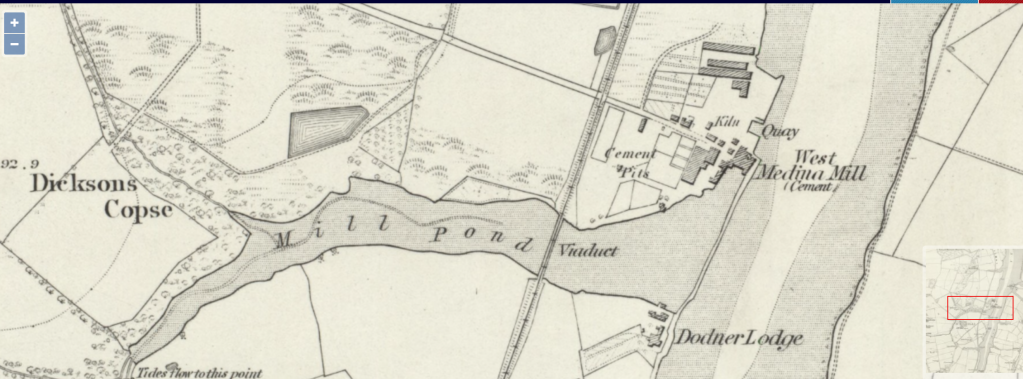
As Alan Dinnis points out in his book “West Medina Cement Mill”, conditions must have been far from pleasant. “Despite being situated on the banks of a pleasant river and two miles from the nearest town, life for the employees at the West Medina Mill was far from tranquil. The large rotating kiln, the crushing balls of the mill and the banging gas engine created a continuous noise that was present all day and all night. in addition to this, the whole premises became caked with a layer of cement that was several years thick. The discharge from the chimneys ensured that the fine white dust spread as far as the surrounding fields”. The mill was situated only two miles from Queen Victoria’s residence, Osborne House, and she complained about the smoke from the mill’s chimneys polluting the air. Essentially the family were living on an industrial site, not the healthiest or safest place to bring up a family.

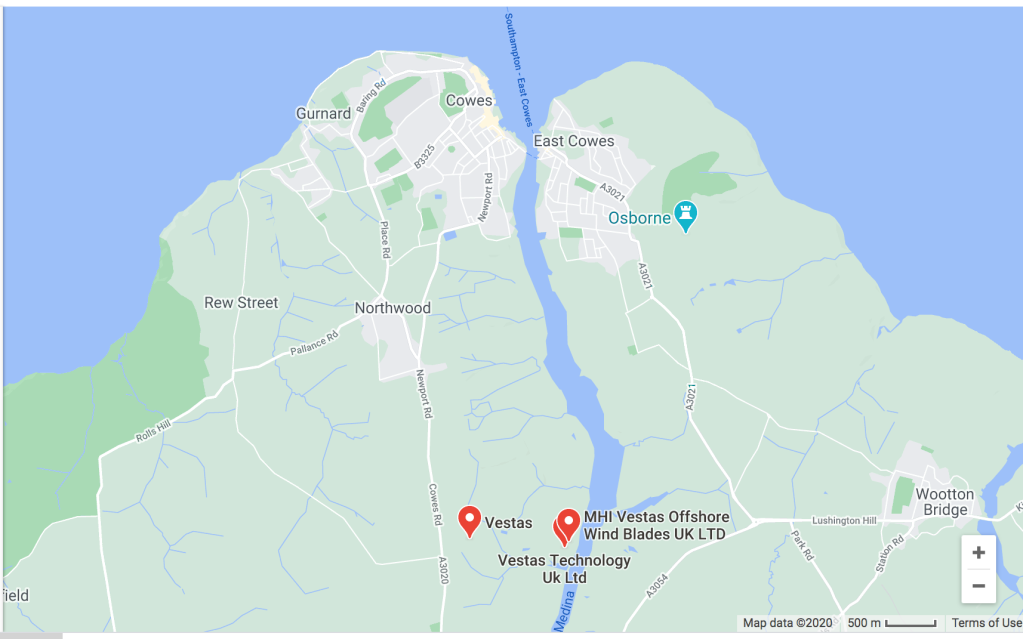
Google Maps 2020 http://www.googlemaps.co.uk
George Thomas Powell and his wife Eliza Jane continue living in the cottage at the cement mill. In the 1881 census, George is described again as an engine driver and his in-laws, the Woodbines, are near neighbours. His uncle and aunt, Henry Glaysher and his wife Sarah, had moved to nearby Carisbrooke by this date but Henry is still an engine driver at the cement works.
In 1886, a tragic event occurred that must have had a huge impact on George. His aunt, Sarah Glaysher, commits suicide. The details were in a newspaper report of the inquest:
SUICIDE BY AN ELDERLY WOMAN. ─On Thursday afternoon the Deputy-Coroner (Mr. E.F. Blake) held an inquest at the Guildhall, relative to the death of Sarah Glaysher, aged 62 years, wife of Henry George Glaysher, Vectis Cottage, Hunny-hill, who committed suicide by hanging, on the previous night. ─The husband of the deceased stated that on Wednesday his wife had been washing all day. She said she did not care about any tea, and had half-a- pint of ale instead. He had a game of cards with her in the evening. When he fetched the supper beer she would only taste it. As was his custom, he went to bed at 10 o’clock. At a quarter past 10, as deceased had not come upstairs, he called out to her, but received no answer. At half-past 10 he got out of bed, and found that the door was fastened. He tried to open it, and failed at first, but afterwards succeeded, and then found the deceased hanging behind the door, being suspended from a peg by means of strap. He cut her down, but she was dead, although the body was warm. There was a stool a few feet off. Witness, being deaf, heard nothing of his wife from the time he left her to the time he found her hanging behind the door. Deceased had a bad appetite, and a little drink would soon overcome her. She was not the worse for drink on Wednesday night; in fact, she was more sober than usual. Deceased’s father committed suicide about Easter time, and this seemed to have affected her mind. Other relatives of his wife had also committed suicide. ─Kate Collins deposed that she had been lodging at Vectis Cottage for the past twelve months. She noticed nothing unusual in deceased’s manner on Wednesday. Shortly before 10 o’clock she went to bed, and at half-past 10 she heard the last witness thumping at the door. Mr. Glaysher called her, and when she went downstairs he had just cut his wife down. Deceased was of an excitable disposition, but her husband was very indulgent. ─Mr. R. Bird Wilkins, surgeon, proved going to the house, and seeing the body. He removed the strap from the neck, and he had no doubt death was caused by strangulation. He had known the deceased for some years, and had reasons to believe she was of intemperate habits. If insanity was hereditary in the family, intemperance would increase the tendency to commit suicide. ─The jury returned a verdict of ‘Death from hanging, she being at the time temporarily insane.’
Isle of Wight Observer April 26th 1886
This is such a sad story and the whole domestic scene is described in detail. Sarah Glaysher was described as being of an “excitable disposition” and of “intemperate habits”. Of particular note was her husband’s testimony that insanity was hereditary in the family, as other relatives had committed suicide. Her father’s suicide, which had happened around the same time of year, at Easter, may have caused her depression.
Within a year, Henry Glaysher married again at the age of 72. His new wife, Harriet Daniels, was his late wife’s niece and the sister of Charles Daniels, the nephew who they had living with them at the time of the 1871 census. Harriet was 30 years old so 42 years his junior, and they moved to Teddington, Surrey, where Henry died in February 1891. He left a will but George Thomas Powell was not a legatee.
At the time of the 1891 census, George Thomas Powell was still living with his wife at 1 Cement Mill Cottages and was described as an engine fitter. The children had all left home. My great grandfather had moved away to the cement works at Cliffe, Kent, to work as a cooper, (no doubt taught the skills by his maternal grandfather, Henry Thatcher Woodbine, as this was the latter’s trade). Their eldest daughter, Elizabeth, was already married and the two younger daughters were working elsewhere on the island as servants.
It must have been a huge shock to Eliza Jane when a few years later, her husband died suddenly, early one morning, on his birthday! This was reported in the local newspaper:
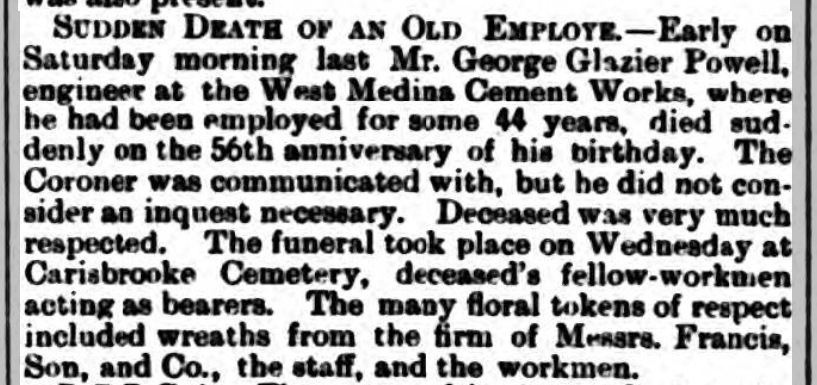
www.britishnewspaperarchive.co.uk
It is interesting to see that in the newspaper report, George Thomas Powell is recorded as George Glazier Powell. This suggests that he also used his uncle’s name of Glaysher. Henry Glaysher must have been a father figure to him since his childhood and of course, he had also worked alongside him for many years. George was described as an engineer and it was stated that he had worked at the West Medina Cement Works for 44 years. Of particular significance is the fact that he had died on his birthday, this being the previous Saturday, June 23. The newspaper said it was the occasion of his 56th birthday, making his year of birth 1838. However, his age on his death certificate and on his headstone is 55. You can see how the discrepancy could occur but looking at census records too, it seems likely that he was born on June 23rd 1839. Unfortunately, he did not leave a will but his widow and family erected a beautiful headstone in his memory in Carisbrooke Cemetery:
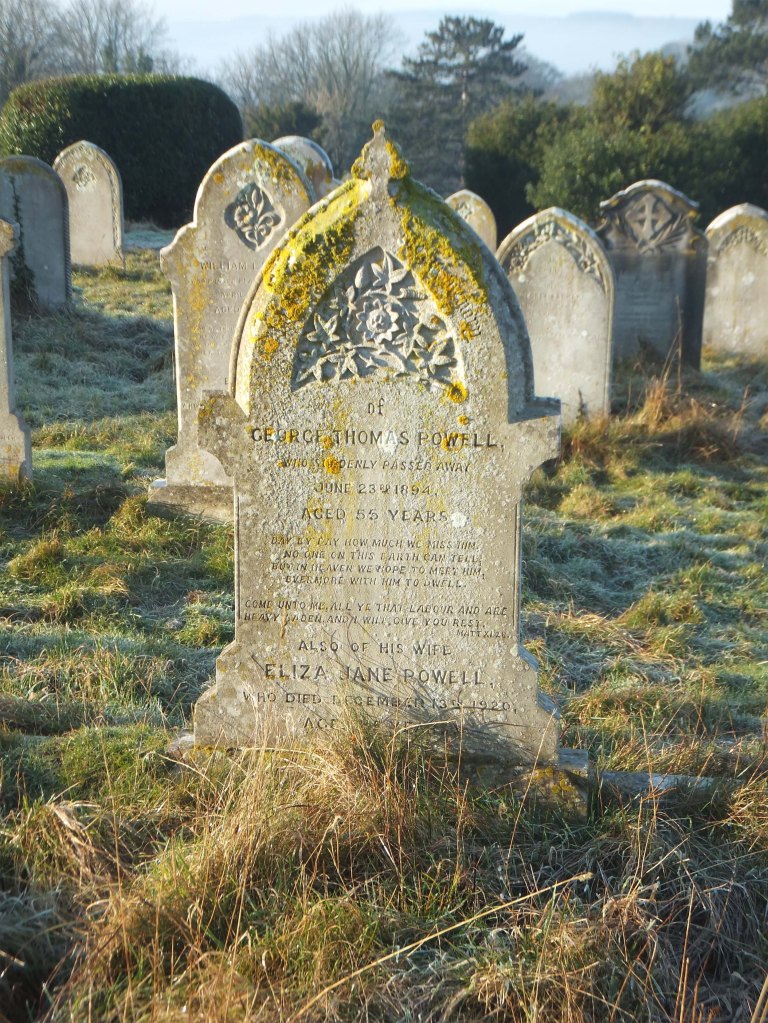
Image courtesy of Friends of Newport & Carisbrooke Cemeteries
I had been able to build up a good picture of the life of George Thomas Powell. He had lived on the site of the West Medina Cement Works in Northwood, on the Isle of Wight from at least the age of 12. However, to discover more about his early life, I needed a record of his birth, which would have taken place in the early years of General Registration. All the census records reported that he had been born in Chiswick, Middlesex, and he said his father was Benjamin Powell, a carpenter, when he married in 1863. Given his alleged birthday of June 23 1839, his birth was likely to have been registered in the September quarter of 1839 in the registration district of Brentford, which covers Chiswick. However, there were no likely entries in the GRO indexes, despite searching these from the September quarter of 1837 to the December quarter of 1841. The only George Powell birth registered in Brentford for this period was a George William Powell in the June quarter of 1839. His mother’s maiden name was Goldsmith. There were no George Thomas Powell births in Middlesex in this period, or anywhere else for that matter.
Next I searched for the marriage of Henry Glaysher and his wife Sarah, George’s uncle and aunt, to discover Sarah’s maiden name. I discovered that Henry Glaysher had married Sarah Beard in 1838 in Acton, Middlesex:
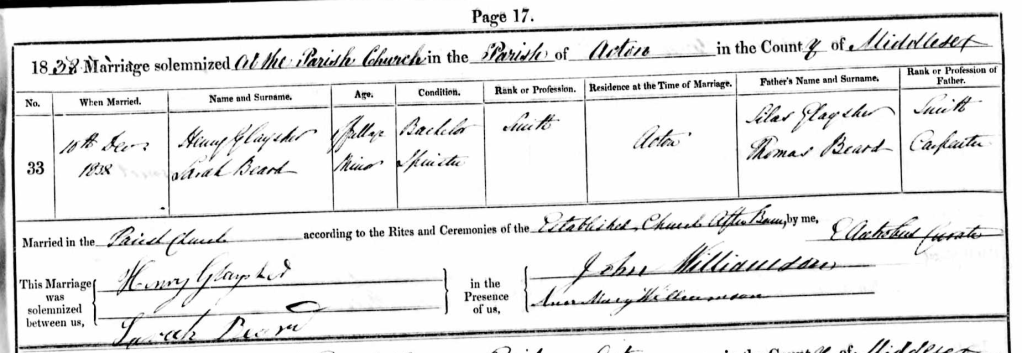
London Metropolitan Archives London, England; Church of England Parish Registers, 1754-1921, dro/052/019
http://www.ancestry.co.uk
Henry Glaysher married Sarah Beard on December 18th 1838 in the parish church in Acton, Middlesex. Sarah said she was the daughter of Thomas Beard, a carpenter and was a minor at the time, so under the age of 21. In fact, a search for her baptism in Chiswick revealed that she had been born in June 1823 so she was only 15 years old when she married! Did her sister marry Benjamin Powell? Perhaps Thomas Beard had got to know Benjamin Powell through work, as they were both recorded as carpenters.
My theory was confirmed when I found that the marriage of Benjamin Powell and Mary Beard had taken place on January 29th 1827 at the parish church of St Nicholas, Chiswick:
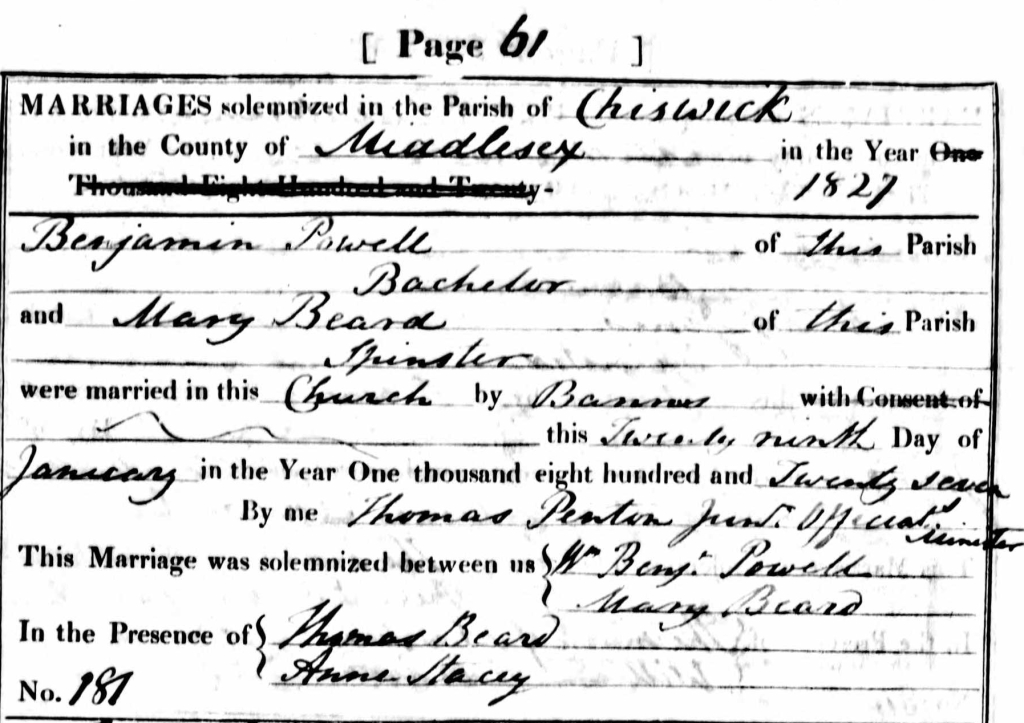
http://www.ancestry.co.uk
Both parties signed their names but a small squiggle in front of Benjamin looked like “Wm”. This suggested that the groom’s full name was in fact William Benjamin Powell but it seems he preferred to use his middle name of Benjamin. Thomas Beard was one of the witnesses.
I found the baptisms of three children of Benjamin and Mary Powell in the registers of St Nicholas, Chiswick. The family were resident in Turnham Green, an area of Chiswick, and also Hammersmith. Benjamin Powell was recorded on each occasion as a carpenter and his wife was named as Mary Ann when their daughter Emma was baptised:
Emma Powell – born October 28th 1827, baptised December 25th 1827
Mary Ann Powell – born August 24th 1829, baptised September 13th 1829
Elizabeth Powell – born April 4th 1832, baptised April 29th 1832
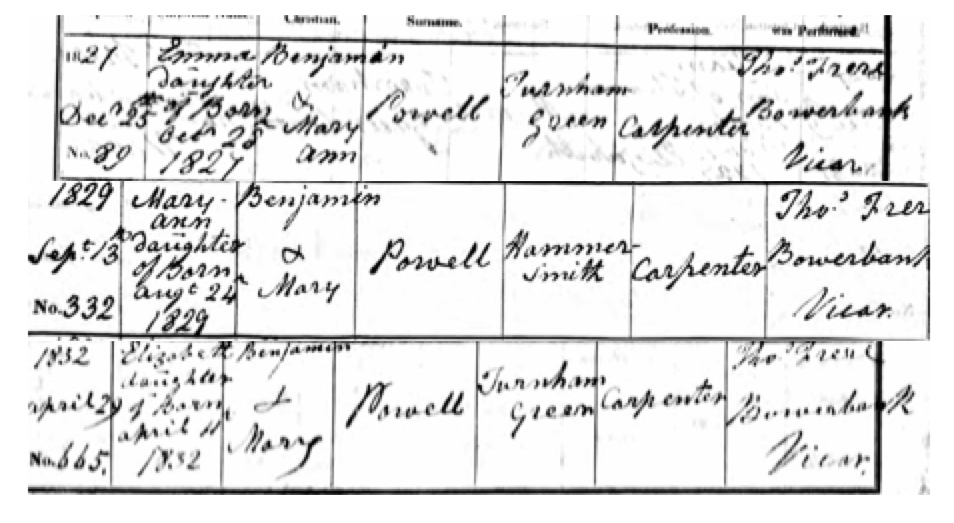
I found one other baptism recorded in the parish registers of St Marylebone:
Benjamin Thomas born 26 November 1835, baptised 24 January 1836
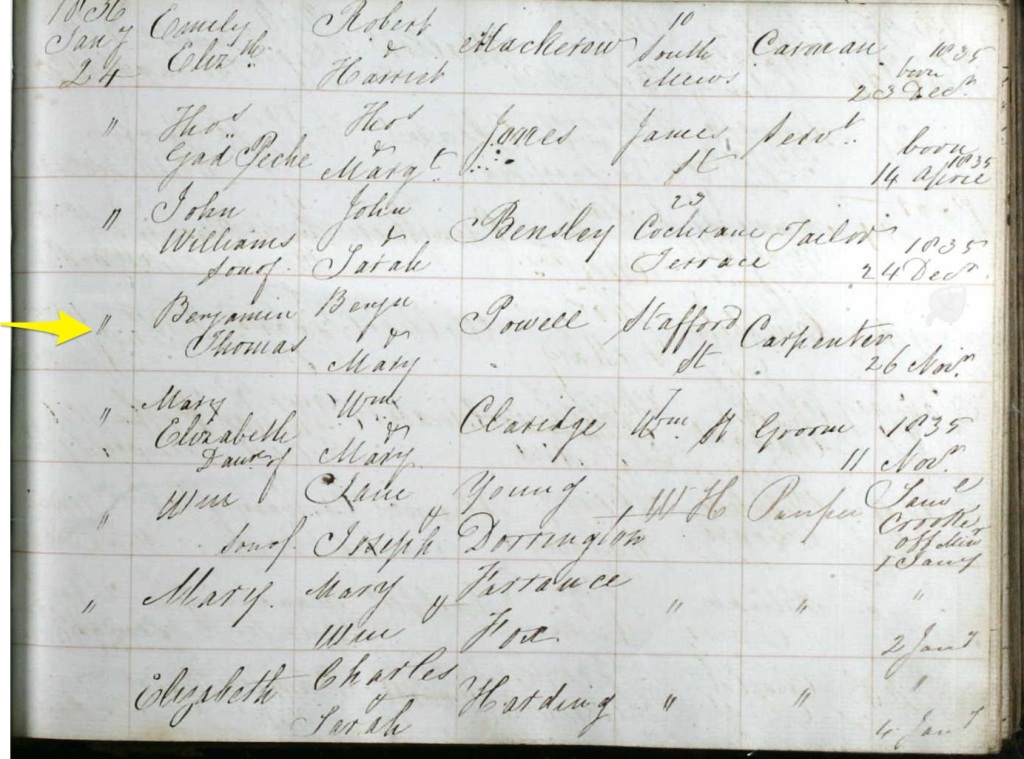
London Metropolitan Archives; London, England; Board of Guardian Records, 1834-1906/Church of England Parish Registers, 1754-1906, P89/MRY1/101
http://www.ancestry.co.uk
It looked as if the Powells were a mobile family. Given that Benjamin Powell was a carpenter, it would be necessary for him to travel to where work was available. Chiswick and Hammersmith are waterside parishes to the west of the City on the Thames, so it is possible that Benjamin worked as a carpenter on boats. St Marylebone is a little closer to the City.
Unfortunately, I could find no sign of the baptism of George Thomas Powell ca. 1839, despite there being good coverage of London baptismal registers at this date on both Ancestry and FindmyPast. In case his baptism had been mis-indexed, I also searched the original registers of St Nicholas, Chiswick from 1837 to 1841 inclusive but without success.
In recent years, the General Register Office (GRO) has made it possible to search for all the children of a married couple, using the maiden name of the mother. I therefore searched the GRO indexes for all Powell births where the mother’s maiden name was Beard from the beginning of General Registration, the September quarter of 1837, until the March quarter of 1851. Perhaps the forenames of George Thomas were different on his birth certificate. I was pleased to find one Powell birth where the mother’s maiden name was Beard, registered in the June quarter of 1838 in the registration district of Brentford. I obtained a copy of the certificate:

On this record, the full name of the father is recorded as William Benjamin Powell and he was the informant. The exact time of baby William’s birth is given, 4.30 a.m. This was usually only noted when there was a multiple birth but in the early years of General Registration, local registrars were getting used to the rules. At this date the Powell family were living on Church Street in Twickenham, another riverside parish, slightly further west of Chiswick. If George Thomas Powell had indeed been born on June 23rd 1839, he would have been the next child, born some fourteen months later. Unfortunately, I could find no baptism for William in any of the online indexes, despite the archivist of St Mary Twickenham, searching the original registers as an extra check.
It has been frustrating to find no birth certificate or baptism for George Thomas Powell, despite ostensibly knowing the identity of his parents and siblings. Since he had the misfortune to die on his birthday, I believe he was born on June 23rd 1839 and in every single census from 1851 to 1891, he said he was born in Chiswick, Middlesex. Why would his brother William’s birth be registered in 1838 but not his? Although the older children of Benjamin and Mary Powell had been baptised, perhaps this was not the case for the younger boys, William and George Thomas. Alternatively, maybe they had been baptised in a parish where the registers have not been indexed. Whatever the reason for the absence of these important records, I was determined to find this missing child.
Next time, I will tell you about the next stage of my research into the origins of George Thomas Powell and reveal an extraordinary twist in the story that has recently come to light.
© Judith Batchelor 2021
I am indebted to Alan Dinnis, the author of “West Medina Mill” for background information on the cement industry and working life at the West Medina Cement Mill.
Another fascinating story! How incredibly sad about the suicide. Isn’t it wonderful when an ancestor stays in one place for so many years? I have a similar problem searching for my great grandmother’s birth and baptism. I found all of the birth and baptism records for her siblings but she remains elusive – perhaps as a result of her parents arriving in Liverpool from Ireland just before her birth. I’m looking forward to hearing about the twist in George’s story.
LikeLiked by 1 person
Thanks Gill! I found the report of the suicide very moving. This old couple, married nearly 50 years but with no children, playing a game of cards in the evening, the husband then going up to bed and his wife not joining him.
Amazing that not only did G.T. Powell stay in the same place, he lived on the site of a cement factory! Convenient for work though and no doubt it was a tight knit community.
Good that you have figured out a plausible reason for the missing records of your great grandmother. It tells you what a huge thing it must have been for the family to be uprooted from their home in Ireland to start a new life in Liverpool.
Looking forward to revealing more of George’s story in Part 2.
LikeLike
It’s so sad to hear about Sarah’s death, and the history of suicide in her family. Her father is your direct ancestor, right?
It’s also very interesting reading about the millworks. How typical of Queen Victoria to complain about it, when people were living right in the midst of it!
I’ll be on tenterhooks waiting for part 2 …
LikeLiked by 1 person
Yes, I believe so! The report on Sarah’s suicide helped me to find out what happened to her father. Another sad story.
Apparently, the Alkaki Act of 1881 was the first piece of legislation that attempted to clean up the environment. The Queen was approached at Osbourne House to sign it and she looked out of the window and asked whether it covered the cement works in the distance. Apparently it did not, as the Act only dealt with black smoke from factories whilst the cement mill smoke was white. The Queen refused to sign the Act until white smoke pollution was included.
LikeLiked by 1 person
A fascinating piece of research. Well done for you persistence
LikeLiked by 1 person
Thanks Heather!
LikeLike
Thank you again for such an interesting and touching story. Yet another similar tale from my research into my husband’s ancestry. I have actually also titled my document “The missing child”! The only one of a large family without a birth registration or baptism, yet. I waiting eagerly for the next stage of your tale to see if there will be a clue I may follow.
LikeLiked by 1 person
That’s a real coincidence that you have a similar scenario in your husband’s family! I hope you find some clues from the story of my research.
LikeLike
Another great piece of work Jude and some wonderful sleuthing as well. It really is annoying when everything slots together nicely and for one reason an ancestor just appears to slip through the net! As there is a part 2 I already anticipating that you might have finally found his birth record!! So awfully sad about the suicide, tragic circumstances and just shows that some traits we inherit can dictate the life we lead, very sad part of the story.
LikeLiked by 1 person
I will have to keep it under my hat so to speak! 😄
The suicide was indeed terribly sad, though it gave me some clues. It is clear that there wasn’t much understanding of depression at the time. You imagine that she and Henry were close though, from the description. They also had a very long marriage – it would have been their 50th anniversary that year. Mind you, Henry seems to have moved on quickly. I haven’t found any memorial to Sarah. 😢
LikeLike